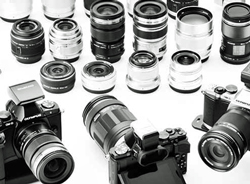The Japanese Camera & Imaging Products Association (CIPA) has revealed its outlook for camera shipments in 2012, with strong growth anticipated in interchangeables and lenses.

The total shipments of digital cameras in 2011 (the cumulative total of shipments from January to December) reached 115.5 million units.
CIPA began compiling records in 1999, when digital cameras were still in their infancy. Since then, digital camera shipments recorded steady growth, reaching 100 million units
for the first time in 2007, but in 2009 sales slackened year on year for the first time, due to the impact of the global recession.
In 2010, total shipments started growing again and reached an historic-high of more than 120 million units. However, total shipments in 2011 fell for various reasons, including the Japanese eathquale and tsunami, March 11, and floods in Thailand, damage from which grew more extensive starting in the latter part of October.
Following the earthquake, total digital camera shipments between June and September rose year on year. In November, when flooding in Thailand became more serious, total
shipments fell to less than two-thirds their level for November 2010; in the following
month, December, total shipments, however, recovered to almost 90 percent their level for
December 2010.
Total shipments in 2011 held firm, declining only 4.9 percent on account of continued strong global demand during the period between disasters, and signs of a robust
recovery in production and supply systems.
In a breakdown by product type, shipments of digital cameras with built-in lens (compact digitals) totalled 99.8 million units, a year-on-year decrease of 8.1 percent;
shipments of interchangeable lens cameras reached 15.70 million units, a 21.8 percent increase, and shipments of lenses for interchangeable lens cameras amounted to 26 million, a 19.9 percent increase, exhibiting solid growth overall with especially conspicuous results in categories with higher added value—system products composed of a camera and interchangeable lens—which drove the market during this difficult time.
The 2012 outlook
The forecast for total shipment (the cumulative total of shipments from January to December) of digital cameras in 2012 is 117.3 million units, a year-on-year increase of just 1.6 percent.
In a breakdown of digital cameras by product type, shipments of cameras with built-in lens and those with interchangeable lens are forecast to reach approximately 99 million (a year-on-year decrease of 0.8 percent); and 18.3 million units (a year-on-year increase of 16.6 percent), respectively.
Outside of Japan, shipments of digital cameras with interchangeable lens is anticipated to reach 16.7 million, a year-on-year increase of 17.6 percent.
Total shipments of lenses for interchangeable lens cameras have a 2012 CIPA forecast of 30.9 million units – a year-on-year increase of 18.8 percent.





I’d like to reinforce the importance of the CIPA data to the Australian market. One of the reasons the lens market is growing at a rate even above camera sales is that as new users to SLR and CSC explore the capabilities of their cameras, they quickly realize the limitation of their 18-55mm (or equivalent) standard zoom. They want to explore wider angle or longer telephoto images, or Macro. Even if they purchased a twin-kit (60% of all ILC sales were in this form), the “do I leave the big lens at home?” question comes up. Again, the user gets a poorer experience, even though they actually own a solution to it. Convenience is a vital part of more frequent camera use. So is creative potential.
At Maxwell we saw an explosion of growth in the last several months in Ultrazoom, with Tamron’s 18-270mm VC lens. This has become the industry’s No. 1 go-to lens for travellers and sports mums and dads. 15X in a DSLR just gives so many more picture-taking opportunities. It’s one of the reasons Tamron just introduced an 18-200mm lens at an affordable price for the diminutive Sony NEX system. If it’s convenient enough, people use it more. It is also a strong growth area in Compact Point & Shoot cameras, where cameras above 10X saw growth last year over 30% in an otherwise down market.
In the marketplace I observe strong sales for Nikon’s 18-200VRII, Canon’s 15-85mm, all giving users a broader image experience than a standard lens. The national ratio of lenses achieved around a 1.8:1 average last year. In days gone by, with more fixed focal length lenses, ratios often exceeded 2.4:1. Because of zoom we may not get back to those ratios again. But, by using education classes that show people how, by offering lens trials, working with suppliers to enable this to happen, – retailers can carve out a very important growth opportunity that increases the ASP (Average Sales Price), creates growth dollars and margins, and gives the end-customer a wonderful extension in their photography.
For Specialists there are great opportunities to explore niches, such as Lensbaby’s new Edge 80 lens, announced this week – one moment a super-sharp portrait lens, next a creative slice of focus for a really different look and feel.
By getting customers involved more with this (and just not to be too one-eyed it could equally be a fisheye from our competitor Sigma!), retailers have much more to offer than just price, and customers get to realize their creative potential.